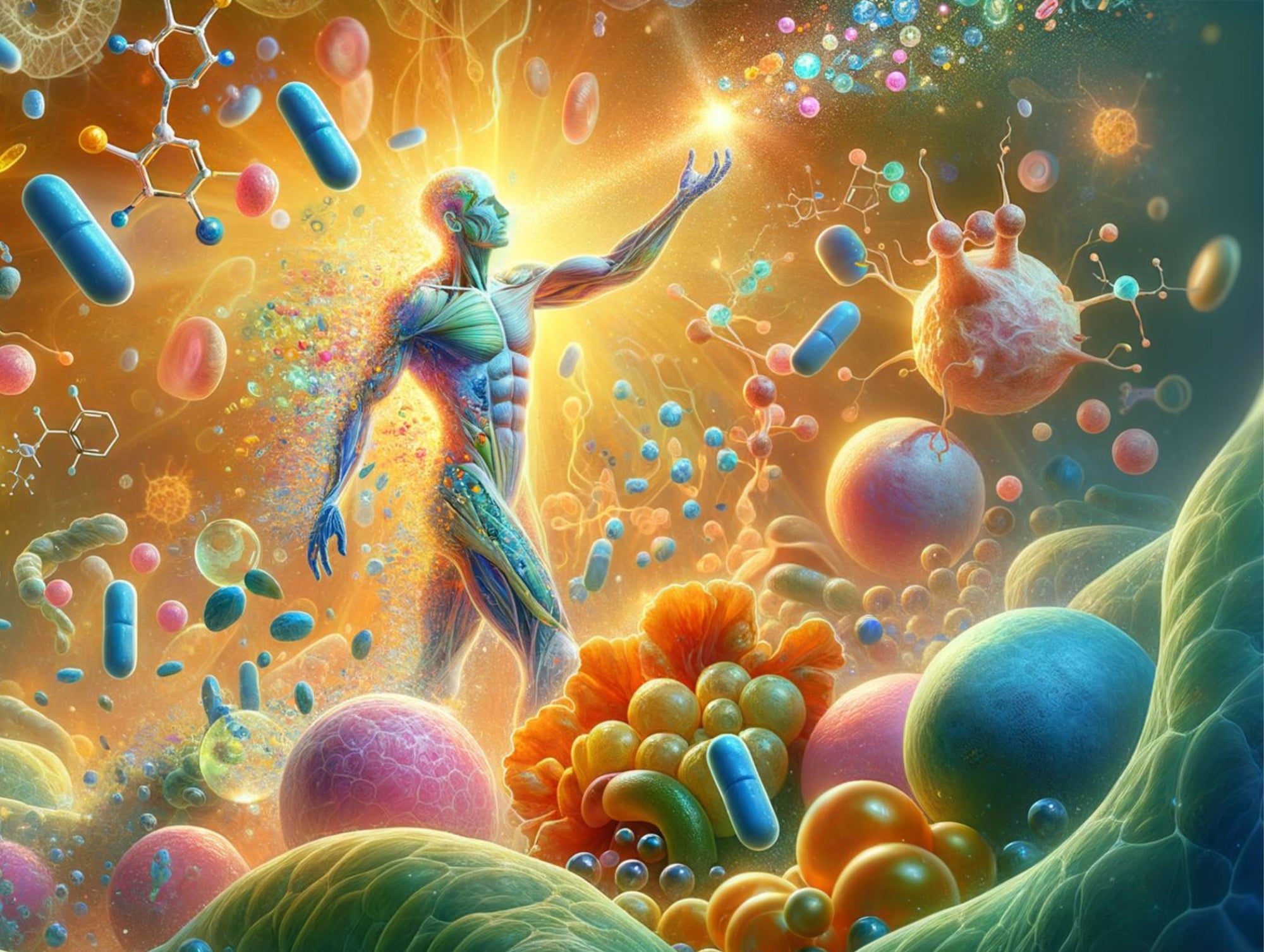

What is a free radical?
Ch 3 of Dr Kim Young Kwi's Book: The Secret of Life-Giving Water
There are several ways in which human bodies discharge waste and free radicals produced within human body. A healthy person processes waste and free radicals in robust and efficient manner, however in less than healthy or in an elderly person, the waste and free radical removal process is slowed down, and in turn cannot stop the ill effects of free radicals. This is the reason why we age and suffer from chronic and degenerative diseases.
Human Body's Fight against Free Radicals
The record for survival without eating food is about 100 days; however, no one can survive for more than a few days without water. The fact that no one can survive for more than a few minutes without breathing air, may contribute to common misconception that oxygen is good for the human body.
The earth's atmosphere consists of about 20% oxygen. While living organisms depend on oxygen for its survival, the very same oxygen contributes and hastens their death. Oxygen is exceptionally a strong provider of energy for all living organisms; any living breathing organisms are therefore subject to free radicals produced from the very act of breathing, in other words, due to the strong reactive power, oxygen poisons and attacks the living organisms. Human bodies depend on oxygen for survival; ironically human bodies must also wage continuous warfare against the by-product of breathing oxygen-free radicals. Eventually human bodies lose the ability to battle against free radicals and succumb to oxidative stress, disease, and ultimately death.
A tree which does not require oxygen can grow without limits, until the environment cannot support the tree anymore, which means the tree will continue to grow until it dies.
Human bodies differ from trees, we grow until the about the age of 25, after which we begin to grow old. There is perhaps sequence or order in the way things and beings are born, however there is no sequence or order in death.
Regardless of age, when human bodies are subject to relentless oxidative stress and attacks from free radicals, the inevitable aging process hastens death through disease.
If human bodies can somehow slow down the harmful effects of oxidative stress and free radicals, youth and health is assured and results in longevity.
It has been long known that degenerative diseases and premature aging is due to oxidative stress (harmful free radicals). Even seemingly invincible steel, left alone invites unwelcome guests known as oxidation, inevitably turning steel into brittle powdery rust. Human bodies are similar to steel. Gastrointestinal problems, pollutants, and stress create free radicals which attach themselves to weakened and vulnerable cells, causing even healthy cells to become diseased. Therefore humans have long understood that oxidative stress and free radicals are at the heart of degenerative diseases, it is important to understand that how we need to fight against oxidative stress and free radicals will determine health and longevity of individuals.
Some free radicals occur naturally, as your cells burn food for energy (a process called oxidative metabolism). Other free radicals come from exposure to ultraviolet radiation (sunlight), radon, x-rays, pollutants, pesticides, food additives, alcohol, and other toxins, causing human bodies to weaken, afflicting human bodies with degenerative diseases and ultimately death. Therefore, it is critical to understand that oxidative stress and free radicals are the root causes of aging and degenerative diseases, and the ways in which we fight oxidative stress and free radicals determine our health, and longevity.
- Two Faced Nature of Active Oxygen (Free Radicals)
If you compared ordinary oxygen to a mewling kitten, free radicals can be described as a fearsome lion, awesome in its intense and violent reactive power. Even at low temperature, free radicals react and bond with various elements, oxidizing them mercilessly. Such violent reactions should not take place within human bodies, as nutrients in human bodies, if left alone, becomes prey to microbes and virus. Human bodies' immune system uses active oxygen to counter and kill invading horde of germs and virus from the environment.
Furthermore, cells and materials wastes generated by human bodies are disposed of by use of active oxygen. The process can be similar to cremating a diseased and deceased body. In addition, nitrogen monoxide (i.e., monoacidic water) and hydrogen peroxide (i.e., oxygenated water) play an important role in cellular propagation.
The ironic question posed here is how such a helpful and important element called active oxygen ends up harming us? There is an old Korean saying, "If anything is done to an excess, it is worse than lacking it in the first place."
Active oxygen is two faced in nature. While it helps to protect the human body from external germs and virus, it can also pose a great danger to the human body.
Standing army of a country can pose similar threats, as the protector of the country and citizens to guarantee security and peace, or as an instrument of oppression turning the guns on its own citizens-nothing can be scarier.
This is the dual nature of active oxygen. While active oxygen is helpful and important to the human body as it counters invading germs and virus, active oxygen may also attack the very cells of human bodies with lethal results. Such process is actually happening in our bodies this very minute.
Why? It is due to the fact that human bodies' tendency to produce excess quantity of active oxygen, much more than necessary to maintain health, allowing the excessive quantity of active oxygen (i.e., free radicals) to commit deplorable acts of violence.
The crime committed by active oxygen includes destruction of genetic, cellular and protein materials, causing a wide variety of chronic degenerative diseases.
The list of active oxygen caused diseases is numerous: dementia, Alzheimer disease and Parkinson's related human brain diseases, various forms of cancer, diabetes, cataract, arteriosclerosis, atopic dermatitis, allergies, inflammation of the liver, nephritis. In addition active oxygen causes liver spots, freckles, and other age-related diseases.
- Enzymes Fighting Against Active Oxygen
Our lungs intake oxygen to break down the nutrients from foods we eat, therefore our lives depends on energy from combustion.
Automobiles burn fossil fuel to generate energy, but the process emits exhaust as a waste product, in a similar manner, about 2 to 3% of what we breathe in becomes active oxygen. Furthermore, exposure to radiation and electromagnetic fields, or stress may contribute to excessive production of active oxygen inside our bodies.
Human bodies employ several different enzymes to get rid of excessive active oxygen. Some of these enzymes are superoxide dismutase (SOD), catalase, peroxidase. SOD is an efficient enzyme; it catalyzes the neutralization of superoxide (i.e., free radicals) into oxygen and hydrogen peroxide.
Hydrogen peroxide in turn reacts with catalase and peroxidase and becomes harmless water and hydrogen, allowing them to be easily discharged from human body. Thus, enzymes such as SOD, catalase and peroxidase must work in cooperation with each other. In a healthy person, these helpful enzymes are working harmoniously and continuously fighting against the ill effects and ageing, whereas in less than healthy or elderly person the enzymes do not function as they should and allow the body to succumb to the deleterious effects of active oxygen. This is the very reason why people become sick with degenerative diseases and grow old.
In order to protect our health from ill effects of oxidation, it has long been our goal to improve antioxidant processes within our body. It is now possible to achieve this goal through drinking the right kind of water. This water is none other than natural-electrolyzed water.
- Protect the Body from Oxidation
Why do some people look older than others? There are people that look younger than their physical age, whereas as some folks look much older than their physical age. This is due to the fact that some people tend to age prematurely from faster rate of oxidation, whereas as some tend to retain youth longer due to a slow rate of oxidation within.
A healthy long life is defined as maintaining youth and health. If you break an apple into a half, you will notice that it soon turns brown. This is due to the "polyphenol" reacting with oxygen. The very same process takes place within our bodies; it is the main cause of degenerative diseases and premature aging. Free radicals cause diseases such as cancer, diabetes, high blood pressure, atopic dermatitis, allergy and numerous others.
These are non-infectious diseases, modern diseases which originate within our bodies. Also known as adult-onset diseases, it is sadly true that the modern medical science does not and can not offer any easy cure. According to the Korean Health Ministry's published study, the chronic diseases rate from 1995 at 29.9% jumped to more than 46.2% by 2002.
What does this mean? Our modern living environment, foods and drinks we eat and absorb, including water are becoming highly oxidized, and our bodies are succumbing to the oxidative stress of our environments and prey to ever increasing rate of chronic diseases, and the modern medical science can not offer any cure.
- Laws of Oxidation and De-oxidation
The nature of things takes place with interaction between plus and minus. When there is a balance between the two opposite poles' interaction, we can forge ahead and maintain good health.
Human bodies contain about 65 different elements, internally maintenance is accomplished by plus (+) and minus (-) interaction, in other words governed by "the laws of oxidation and de-oxidation."
Oxidation describes the loss or separation of an electron by a molecule, atom or ion. Returning or reinstituting a loss electron is referred to as de-oxidation. If you count up all of the elements present in the nature, there are about 109 different kinds of elements altogether. These elements when examined closely reveal that they consist of atoms. If atoms are broken down even further, it reveals that there is an atomic nucleus, which is an electron circling a neutron.
Atomic nucleus and electron can be thought of in human terms as a husband and a wife. The size of the atomic diameter is about 10-9 to one centimeter. Atoms are composed of three subatomic particles: proton, electron and neutron. The proton carries an electric positive charge, whereas the electron which orbits the atomic nucleus is negatively charged. The electric charges of proton and electron are equal in value but opposite in sign to the charge; therefore electric charges are internally balanced.
Elements in nature are electrically balanced, proton is like a husband and electron is like a wife in a harmonious relationship, because electron endlessly orbits around with proton in eternal balance ensuring a happy home.
- Promiscuous Nature of Hydrogen's Electron
Living creatures such as humans and animals consist of almost 70% water (H2O); hydrogen atoms consist of 1 proton and 1 electron, unfortunately hydrogen's electron is very promiscuous and frequently and easily leaves behind its paired proton, out of the atomic nucleus.
All materials and organisms are in the same boat.
Technically, when hydrogen's electron breaks away from the atomic nucleus, the process is described as "ionization" and "oxidation."
That means, oxidation takes place within water, food, air, soil and all materials in the nature made up of atoms. In other words, ionization occurs due to the continual loss of negatively charged electrons.
Fruits, fish, and even meats spoil over time due to "oxidation." You can view oxidation as nature's spoliation. In addition, natural decay and wide variety of pollutants, human ailments, birth of deformed babies, even mental illness can be attributed to this nature's spoliation.
While one can pity the poor proton left all alone, and even try finding an available electron for it, the sad truth is that everything is subject to decay and there is not enough available electrons. Since all materials and organisms are holding onto their dear electrons, it is not an easy thing to take them away at will. Hydrogen's lonely proton, while allowing the electron to wander away, is more than happy to accept any other available electron without much fuss. So long as a suitable female electron can be found, the lonely male proton is always willing to "remarry."
When atoms are surrounded by negatively charged electrons; they work to prevent loss of hydrogen's electron from gas, environmental pollutants, blood and bodily fluids flowing through living organisms.
Source: KYK, Water for Life USA
















